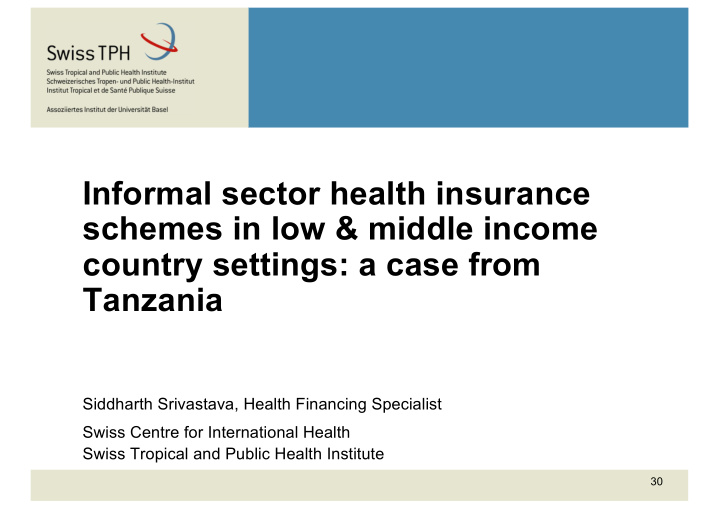



Informal sector health insurance schemes in low & middle income country settings: a case from Tanzania Siddharth Srivastava, Health Financing Specialist Swiss Centre for International Health Swiss Tropical and Public Health Institute 30
• Role of health financing within health systems • Health financing mechanisms • Evolution of insurance models in Tanzania • Evolution of Insurance information systems • Key figures 31
Role of health financing within health systems Source: http://www.who.int/workforcealliance/knowledge/toolkit/26.pdf 32
Health financing link to overall health system goals Source: http://apps.who.int/iris/bitstream/10665/254757/1/9789241512107-eng.pdf?ua=1 33
Tanzanian setting health insurance schemes evolution Single National Health Insurer Multiple: National Health companies – Insurance Fund local/regional Church based, Charitable Community health Health Funds facilities, NGO based, etc. savings groups, Source: http://apps.who.int/iris/bitstream/10665/254757/1/9789241512107-eng.pdf?ua=1 34 etc.
Community Health Fund (CHF) • Piloted in 1996 • CHFs are “voluntary community-based financing scheme in which households pay contributions to finance part of their basic health care services to compliment the government health financing efforts.” • Managed by Local Government Authorities (Districts) and supported by the National Health Insurance Fund (NHIF) • Household enrolment with a predefined household size of 6 – targeting primarily the informal sector • Enrolment for a period of 12 months • Annual household contribution between 5,000 – 15,000 TZs (2.2 – 6.6 CHF) per household and government subsidizes the CHF schemes with matching fund contributions. • Benefits mainly covered primary care and rarely secondary care • Performance was broadly low 35
Reformed CHF approach (CHF Iliyoboreshwa) • Different donor supported efforts to improve and pilot different models • Swiss Development Corporation (SDC) since 2011 funds under the Health Promotion and Systems Strengthening (HPSS) project reform of the CHF • Reformed approach designed and implemented by Swiss TPH since 2012 • Overhaul of the governance, provider payment mechanism, benefit package, processes and operational structure including the development of Insurance Management Information System (IMIS) 36
Insurance Management Information Systems (IMIS) • Swiss TPH worked with a local Tanzanian company to develop a comprehensive insurance management information system • Mobile phones (android apps) used to support enrolment, renewals, client enquiry, claims and feedback processes • Flexibility to accommodate different insurance models, organizational structures, processes, products and provider payment mechanisms • Currently supporting district based government (Tanzania – moving to regional/national), centralized government (Nepal) and mutuelle (Cameroon and Congo) health insurance models • The system was shared with all countries under a free of cost license granted by SDC • Now released as an Open Source application (Affero GPL license) under the “OpenIMIS initiative” funded by SDC and BMZ focussing on provision of a low cost, interoperable and modular health insurance information system. • In Tanzania govt. wants to use IMIS for national roll out of new CHF 37
IMIS – Data captured 38
Evolution of the technology • Driven heavily by implementation needs • Highly dynamic and tech savy environment • Jump to mobile based solutions – more acceptable by users (agents, health facility and clients), easy to further innovate on and relevant skills are available locally • Large number of pilots and solutions lead to fragmented IT landscape and hence emphasis on interoperability to ensure systems talk to each other • Government leading initiatives to bring in standardization and cut down costs • Mobile payment gateways • SMS gateways • USSD technology 39
Key figures from CHF Iliyoboreshwa - 22 schemes (districts) - 1.47 million individuals reached till date - Over 756,000 individuals actively covered (close to 15% of population) at the end of October 2017 - 847 health facilities (primary and higher level) - 2458 enrolment officers at village level 2017 end line survey in one intervention region (Dodoma): - Insured households incurred 37 percent less annual out of pocket expenditure than uninsured households - 2.9% of the surveyed population incurred catastrophic health expenditure with about 72 percent of these belonging to the uninsured group 40
Thank you for your attention! siddharth.srivastava@swisstph.ch 41
Recommend
More recommend